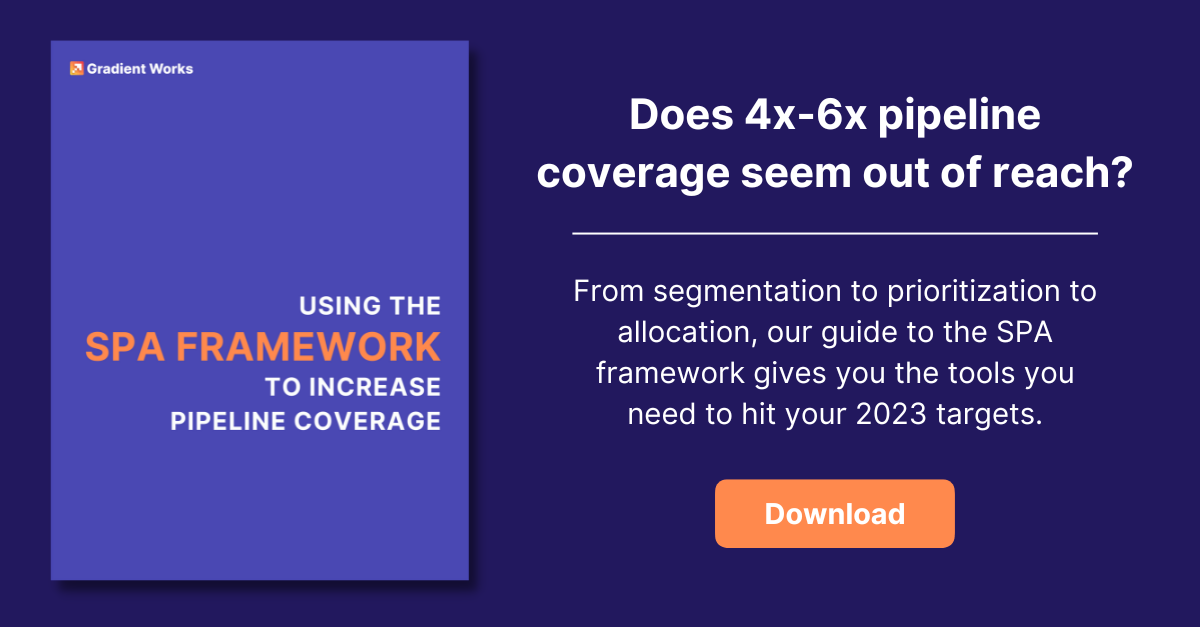Every B2B company defines an ICP and uses various firmographic, technographic, demographic and behavioral criteria to segment the universe of possible customers into accounts they can target. This process of market segmentation and prioritization happens at every single B2B company in the world.
The problem is that most of the criteria we use for this segmentation are based on inaccurate data and faulty assumptions. This results in imperfect and generalized account segments.
Because of that, we waste sales rep time and marketing budget trying to get in front of the wrong accounts. Our GTM efforts are wasteful and inefficient.
Why does this matter? In boom times, we weren’t as worried about waste. We had plenty of sales reps and marketing budget to go around. But now - when pipeline generation is down by 50%, sales cycles are 20-40% longer, win rates are down to 17-20%, and 54% of sellers are looking for a new job - we absolutely cannot waste a single drop of GTM effort or sales quota capacity.
What can we do about it? We need smarter segmentation and prioritization for sales teams, so that sellers can be laser-focused on the highest potential accounts in a company’s market - and that every single high-potential account is being worked by a seller with the capacity to work it thoroughly.
An ideal customer profile (ICP) describes the attributes of the customers who are likely to need your product or services and would therefore be a very good fit for becoming a customer. For example, if you're a B2B company, your ICP might describe the number of employees, industry and revenue of other businesses that would have a need for your product.
Targeted, ICP marketing and sales activities to the right kinds of prospects. Here are a few things to keep in mind.
1. Ensure your ICP is well-defined and precise
Start by conducting a thorough analysis of your existing customer base, identifying the common traits, characteristics, and attributes of your most successful and valuable customers. Use data from your CRM and feedback from your sales team to refine and validate your findings.
Go beyond basic demographics and dig into firmographics, such as company size, industry, and location, as well as behavioral indicators, such as buying patterns, pain points, and specific needs your product or service addresses. Be specific and detailed.
Continuously update your ICP as your business evolves. Review it at least every 6 months, or more often if your ICP is new. Iterate as you learn what criteria actually define the customers who are doing the best with your product or service.
2. Evaluate the firmographics/demographics in your ICP
Typically we think about B2B market segmentation in terms of a few main criteria: revenue, location, industry, and employee count. These broad categories help sales reps approach companies that are similar to each other in some basic way. The goal is to reduce complexity in the sales process.
But these criteria are broad strokes at best. Revenue and employee count are rough estimates of a company’s size, and thus its maturity. That tells us something about its challenges - a 20-person startup with $1 million in annual revenue has far different business challenges than a 4000-person company with $1 billion in revenue.
Location matters only a little to most sales teams, and generally in the more general sense. Is a prospect located in this country or region? That helps us know what language, time zone, and cultural implications we need to take into consideration. But as we’ve discussed many times, more fine-grained geographic criteria (such as state or zip code) is a terrible way to segment accounts. Opportunity is not distributed geographically.
With geographic segmentation, some reps get territories with so many high-potential accounts they can’t talk to them all, while other reps starve in a territory plan with low potential. Relying too much on geographic segmentation can lead to imbalances in attainment, missed opportunities and black holes in your TAM, and painful planning processes. Beyond high-level regional considerations, geographic segmentation is not a particularly useful criterion.
That leaves us with industry. Typically, we tend to cluster prospects into broad industry categories - software, automotive, healthcare, and the like. Those are moderately useful, but would be far more useful if they were more specific. Some companies use NAICS codes to segment account groups, but those codes are not much better than broad industry categories.
Imagine a sales rep who lands a great new customer. They have a compelling use case and are getting a lot from the product. They’re the perfect customer. Of course that sales rep wants to find more prospects like that perfect customer.
Right now, the best way to do that is get some high-level industry data from Zoominfo. The sales rep sees that this perfect customer is classified as being in the software industry. Looking in their CRM, they find 5,000 other accounts that are also classified as software companies. Even if they filter down to just the accounts with a high account score, they’re left with hundreds of accounts. So then they have to decide how they want to dig through those hundreds of accounts to find others similar to this perfect customer. How can you improve this process for your sales reps?
3. Make customized GTM plans based on your ICP market segmentation
For each of your buyer personas or ICP groups, develop a concrete plan for communicating with them. That should encompass everything from top-of-funnel, ICP marketing to sales outreach and demos, and customer success onboarding and implementation. If you don't have a buyer journey content framework, here's a simple one to get you started.
-
Awareness
-
What are the buyer's top challenges and goals?
-
What does the buyer need at this stage?
-
Thought leadership, blog posts, podcasts, category education
-
-
-
Consideration
-
What other options do they investigate?
-
What does the buyer need at this stage?
-
Product tours and videos, testimonials, case studies, reviews
-
-
-
Decision
-
What criteria will they use to evaluate your solution?
-
What does the buyer need at this stage?
-
Custom demos, social proof, references, ROI calculator, installation guides
-
-
-
Success
-
How will the buyer measure success?
-
What does the buyer need at this stage?
-
Support documentation, onboarding playbooks, QBRs, reporting
-
-
Truly understanding your ideal customer helps you focus your sales and marketing energies in the right place. It helps you create an action plan for how you go to market, ensuring everyone across your revenue organization is on the same page. It's worth spending the time on to get it right.





